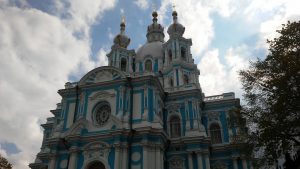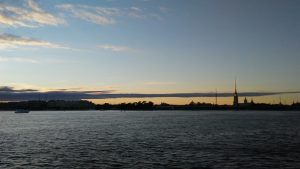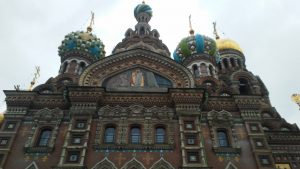By Nicholas Rackers
Like most Americans, I’m descended from immigrants who came to this country in search of a better life. Most Americans are able to live their lives without thinking much of their heritage, but from a young age I was aware of where my family came from. My paternal grandfather was descended from German immigrants, and fought Nazi Germany in World War II. My maternal grandmother was originally from Texas, and was of Irish, Scottish, English and Cherokee heritage. My maternal grandfather was from Cincinnati and was of German and Irish ancestry. My maternal grandmother was from Pittsburgh, and the daughter of Carpathian Rusyn immigrants.
I had always loved learning about history and other cultures, and when I was a sophomore in high school, I started taking a deeper interest in my Carpathian Rusyn heritage. I knew that they came from a region in present-day Slovakia, but I didn’t know much more than that. I was able to spend hours on my laptop reading about the history and people of Carpathian Ruthenia and the rest of Eastern Europe. Afterwards, I discovered that my great-grandparents came from the Carpathian Mountains in between Poland, Slovakia, and Ukraine called Carpathian Ruthenia. Despite my great-grandparents coming from Slovakia, most of the Carpathian Ruthenia region was in what is now independent Ukraine.
I researched the “Rusyn” or “Ruthenian” people that I belong to. They speak an East Slavic language related to Russian, Ukrainian, and Belarusian. In fact, the name “Rusyn” used to be the common name of Russians, Ukrainians, and Belarusians centuries ago. Most belong to the Eastern Orthodox Church or the Byzantine Catholic church. After research and self-reflection on my East Slavic heritage, I realized I was hooked and had to pursue this fascination with Eastern Europe and Russia.
At Miami University, I started taking classes on Russian history, language, politics, and culture. During my freshman year, I even added Russian, East European, and Eurasian studies as a minor to complement my political science major. As time passed, I became only more fascinated with Russia. It became a personal and academic goal to study abroad in Russia.
In the spring of my sophomore year, I decided to act. I applied to the Summer 2017 Russian Area Studies program in Saint Petersburg with the Council of International Education Exchange. My GPA was good, and I knew that I would have completed two semesters of Russian classes by the time the program started. I applied and got accepted into the program by both Miami University and CIEE, the only problem was financing my trip.
Because it was a summer program, my financial aid and scholarships would not pay for anything. I decided to apply for the State Department’s Gilman International Scholarship and hope for the best. I doubted my chances of being awarded the Gilman Scholarship, after all I was only one of hundreds of applicants. To my surprise, I learned in April that I had been awarded the Gilman Scholarship for the amount of $3,000. I immediately called my mom with the good news. I was even able to get a travel grant from Miami University’s Havighurst Center for Russian and Post-Soviet Studies. For the first time, I could imagine myself accomplishing my dream of studying abroad in Russia.
On May 22nd, I arrived at Pulkovo International Airport in Saint Petersburg. I flew from Cincinnati to New York, then to Finland and on to Saint Petersburg. I had never flown before, let alone left the country. I met our guide at a Starbucks in the airport, a cheerful young Russian woman named Ira. With the other students I boarded a small shuttle to meet our homestays.
After an hour, I arrived at 2 Ulitsa Pravdy. The name of the street literally means “Truth Street.” My homestay was a caring young woman named Anna. We shared the apartment with three cats, Semochka, Bagheera (from Jungle Book) and Rysik (bobcat). She always made me great meals, especially dumplings called pel’meni and the famous beet soup called borscht. Even if she had to work, she cooked my food before she left so I could eat it after class.
Ulitsa Pravdy, St. Petersburg. Photo by author.
I studied with five other American students at the faculty of political science at Saint Petersburg State University. The University had been attended by the likes of chemist Dmitry Mendeleev, Bolshevik Vladimir Lenin, scientist and scholar Mikhail Lomonosov, and Russian President Vladimir Putin. The faculty of political science is located on the ground of the old Smolny Convent, and the beautiful white and blue Smolny Cathedral towered over the campus. Next to the campus was the Smolny Institute, the seat of the Bolshevik government after the October Revolution.
Smolny Cathedral, St. Petersburg. Photo by author.
For the next four weeks, we toured the city of Saint Petersburg. “Piter,” as it is colloquially called, was founded by Peter the Great in 1703. Peter the Great, the founder of the Russian Empire, founded Saint Petersburg on territory conquered from Sweden during the Great Northern War. Emperor Peter wanted to introduce the ways of Western Europe to Russia, and as part of his project, Saint Petersburg replaced Moscow as Russia’s capital. Just south of Finland, Piter was Russia’s “window to the West.”
Neva River with Peter and Paul Fortress in background. Photo by author.
Saint Petersburg is modern Russian history in a nutshell. Intended to be a European-style city, hundreds of buildings are built in Baroque and other styles. Imposing, harsh grey buildings serve of a reminder of the Soviet era, during which Saint Petersburg was known as Leningrad. At the same, one shouldn’t be surprised to see a Starbucks or McDonalds on the same street as an Imperial-era church or Soviet-era government building.
Dozens of stunning Orthodox cathedrals and churches designed in European styles dot the city’s landscape. One of the most famous cathedrals in the city is the Russian Orthodox Church of the Savior on Spilled Blood. The cathedral got its name because it was built on the site of Tsar Alexander II’s assassination in 1881. During World War II, the gold dome of the Cathedral of Saint Isaac had to be painted grey so it could not be seen by German spotters.
Church of the Savior on Spilled Blood, St. Petersburg. Photo by author.
At the same time, the city reflects the diversity of Russia, too often forgotten in the West. Islam is Russia’s second largest religion, and the Saint Petersburg Mosque, built in 1913, is the largest mosque in Europe outside of Turkey. The Grand Choral Synagogue is the second largest Jewish synagogue in Europe. For the city’s Georgian and Armenian populations, there are a handful of Armenian and Georgian Orthodox churches. There is a Buddhist temple, and even a few Roman Catholic and Lutheran churches.
On Mars Field, an eternal flame burns bright. The flame symbolizes the millions of Soviet citizens that died during the Great Patriotic War, the Russian name for World War II. More than 20 million Soviet citizens of all ethnic groups died in World War II, and more than a million people died during the Siege of Leningrad.
Eternal Flame, Field of Mars, St. Petersburg. Photo by author.
For an American student like myself, Russia caught me off guard, no matter how much I had read about Russia, its people, and its history. Russia is more than three times older than the United States, and even Saint Petersburg predates the U.S.A by 70 years. Russia’s history is filled with both incredible suffering and accomplishment. The country struggled under the Mongols, lost more than 20 million people in World War II and suffered under Stalinism. At the same time, Russia has given the world the periodic table of elements, Dostoyevsky, Tchaikovsky, War and Peace, Saint Basil’s Cathedral, and the first man in space.
It would be an understatement to say that Russia changed me. Even now I carry my wallet in my front pocket, a precaution I was advised to take to protect against pickpockets. It is not only a habit now, but a reminder of my time in Russia. Other habits haven’t died, like eating buckwheat porridge called grechka or drinking a fermented rye drink called kvass. Of course, my time in Russia only strengthened my fascination for Russia and the Russian people. I am tentatively planning on returning to Russia for my last fall semester, and once again I’ll be blessed to hear Professor Leonid Vladimirovich’s lectures, Ira’s stories, and the wrinkles in Sasha’s English.
We don’t know where life will take us, but take the chance to go somewhere that fascinates you. It could be Spain, France, South Africa, Germany, Italy, China, or any of the other 160+ countries in the world. If money is what’s stopping you, there are resources like the Gilman International Scholarship, Fulbright Scholarship, and university scholarships. If you have the will, there is a way.





